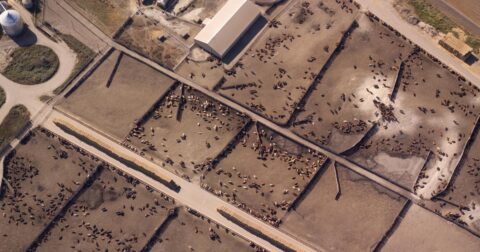Explainer
The Causes and Effects of Deforestation, Explained
Climate•8 min read
Analysis
Emissions from factory farms in the U.S. cause more deaths than coal-fired plants. And yet, factory farming is one of the least regulated industries by the EPA.


Words by Devatha P. Nair
Emissions from factory farms in the United States now cause more deaths than traditional polluting industries such as coal-fired plants, with air pollution coming from agriculture accounting for 17,900 deaths every year. And yet, factory farming is one of the least regulated industries by the Environmental Protection Agency (EPA).
Most farms are currently protected by an amnesty deal that protects the industry’s biggest players from any meaningful enforcement of environmental protection laws. The inability of the EPA to regulate the livestock industry led to 24 advocacy organizations filing a legal petition to enforce federal air pollution laws against high polluting farms, which the agency has refused to do for nearly two decades. The groups are asking the EPA to stop giving factory farms a free pass to pollute and start doing more to protect communities and the environment.
“We are asking the EPA to do their job and to stop using the amnesty deal negotiated between the factory farming industry and the EPA as an excuse to ignore dangerous emissions from factory farms,” said Hannah Connor, an attorney at the Center for Biological Diversity.
This is not the first time the organization has voiced concern over the lack of oversight and inaction by the EPA. “For too long, the EPA has given factory farms a free pass to pollute the environment and refuses to subject them to environmental protection laws that are used to regulate other industries,” said Connor.
More than 250,000 factory farms are now housed disproportionately in low-income rural areas of the country. For the people who live there, these farms are a constant assault on their senses. A recent study identified that of the 55 factory farms operating in Kern County, 33 of them are located within three miles of a public school.
But air pollution is just part of the story. Shrieking animals, polluted waterways, and heightened risk of infectious disease are all irrevocably part of what it means to live next to a factory farm.
Emissions from factory farms, which often go unnoticed because they do not always have an odor, also have significant health effects on surrounding communities. Each breath comes with the price of inhaling ammonia, hydrogen sulfide, methane, small bits of solid particulate matter (called PM2.5), volatile organic compounds, and other hazardous air pollutants.
Inhaling ammonia over a period can corrode the respiratory system, causing asthma, chronic bronchitis, and pneumonia. Extended exposure to hydrogen sulfide, often considered the most dangerous gas produced in factory farms, has been known to cause the deaths of animals and farmworkers.
Perhaps more disturbing is the overabundance of small bits of solid particulate matter, roughly 1/30th the thickness of human hair. These pollutants, which are released from factory farms when car exhaust combines with the ammonia molecules released from animal waste, are referred to as PM2.5. A recent study shows that PM2.5 emissions originating from animal agriculture are linked to higher incidences of cancer, cardiovascular diseases, and stroke, which in some cases may lead to premature death. Kern County also tops the American Lung Association’s 2021 list of counties most polluted by PM2.5 emissions.
As early as the 1990s, the EPA was aware of the impact factory farming was having on the surrounding communities. An agency report from 1996 found more than 70 percent of the ammonia present in the air was emitted from factory farms. Years later, researchers found that exposure to high concentrations of ammonia caused high blood pressure, mental distress, and an overall decreased quality of life for residents of North Carolina’s coastal plain, a region that is also home to some of the country’s largest and least regulated factory farms.
In the early 2000s, the agency began calling for more a “reliable method to estimate air emissions,” which it now calls emission estimating methodologies (EEMs). The new EEMs allowed the EPA to regulate livestock producers by issuing them permits under the Clean Air Act (CAA), the Comprehensive Environmental Response, Compensation, and Liability Act (CERCLA), and the Emergency Planning and Community Right-to-Know Act (EPCRA).
However, in 2005, before the study even began, the EPA struck an amnesty deal with representatives of the pork, poultry, and dairy industries. The EPA would grant participating factory farms–which accounted for more than 90 percent of the country’s largest livestock operations at the time–immunity from violations under CAA, CERCLA, and EPCRA during the study period. The EPA told legislators that the amnesty deal, officially known as the Animal Feeding Operations Consent Agreement, would be revoked at the end of the two-year study, at which point the agency would begin enforcing the relevant environmental protection laws again.
Sixteen years later, air emissions from factory farms are still largely immune from violations under CAA, CERCLA, and EPCRA, while the EPA continues to study new emissions monitoring standards with no end in sight. Today, there are approximately 8.7 billion animals living on factory farms in the U.S., and a vast majority of those farms are exempt from reporting their emissions to the EPA.
The existing data from the EPA’s emission monitoring programs show us an incomplete picture of emissions from factory farms and how they’re changing. Methane emissions from dairy and hog waste, for example, have increased by 80.4 percent since the 1990s. But, as its own research has shown, the agency has more than just methane emissions to worry about, and whether or not it has plans to recognize and actively monitor the industry’s other sources of emissions remains unclear.
While the EPA acknowledges that “agricultural activities” are at least partially responsible for increasing the total greenhouse gas emissions in the U.S., only the largest of the farms that generate over 25,000 metric tons of CO2 equivalent per year are required to report air emissions to the EPA. Farms that underreport emissions or do not meet this threshold receive little regulatory oversight.
In 2017, a highly critical report released by the EPA’s own Office of Inspector General asked the EPA to complete the EEM study by 2018. Five years later, it is still incomplete, and after delaying its rollout more than five times in just two years, the EPA currently lists the date for issuing factory farms new EEMs as May 2022.
The EPA does not have a clean record when it comes to meeting deadlines. As the Center for Biological Diversity, Food & Water Watch, and other advocacy groups pointed out in a recent petition, every time an EPA deadline nears, the agency updates the schedule to give itself more time. The EPA has also reportedly acknowledged in court that it may not finalize EEMs for factory farms until 2037. This would buy the livestock industry another 15 years of regulatory freedom.
Environmental organizations have urged the EPA to use its existing powers granted by the CAA on factory farms and rectify the lack of oversight that has dominated industrial agriculture for almost two decades. But the EPA has consistently used the lack of EEMs as an excuse to deny or ignore almost every petition they have filed since 2009.
In other cases, the agency has doubled down on its commitment to ease environmental restrictions on factory farms. In 2017, a Washington, D.C. Circuit Court struck down an EPA issued guidance that exempted all farms from federal (CERCLA) and some from local (EPCRA) emissions requirements. But the agency promptly issued new guidance exempting farms under both laws. Then, in 2018, the Trump administration signed the Fair Agricultural Reporting Method (FARM) Act into law, which expressly exempts reporting certain types of emissions from factory farms.
The EPA’s inaction has forced advocacy organizations to hold factory farms accountable. In a “landmark win,” petitioners represented by the advocacy group Food & Water Watch, along with the Earthrise Law Center at Lewis & Clark Law School, won a Ninth Circuit challenge to EPA’s statewide water pollution permit in Idaho. The judges unanimously ruled that the EPA’s permit was arbitrary and ran counter to the Clean Water Act.
“For the first time, factory farms in Idaho will now be required to monitor and report on their waste discharge,” said Tarah Heinzen, legal director at Food & Water Watch.
But Idaho is the exception, not the rule. In most states, though, factory farms are still free to pollute the environment as much as they please.